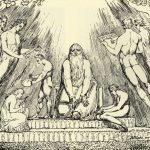Biblical interpretation is a complicated matter that should not be taken lightly. While the usage of an interlinear Bible combined with a concordance does give one an advantage over relying on the many translations available in each language, it still fails to capture the underlying cultural context of the text. In order to understand the text in its original context, in the manner which the author intended it to be understood, it is crucial that the interpreter obtain as much accurate information on the historical, social, geographical, and cultural background of the text as is possible. This enables the interpreter to understand the text in the same manner as the original audience in ancient times. The process of obtaining this background information is not always a simple process and interpreters must remain flexible in their understanding as archaeologist uncovers new information. Much of the archaeological information is also subject to interpretation and as such there are often disagreements between scholars as to the proper contextual understanding of the evidence at hand. Thus it is essential that the interpreter analyze as much of the evidence at hand as possible in order to give the correct interpretation of a Biblical text. The following are four example passages that are analyzed using the available literature in order to expound on the importance of using historical context for interpretation.
The first passage to analyze is the narrative of Abraham’s purchase of the cave of Machpelah found in Genesis 23. Because this passage mainly focuses on the narrative of bartering for a piece of property between Abraham and Ephron, which is a foreign means of land purchase to the modern reader, there is a tendency to regard this chapter as superfluous information that somehow did not get edited out of the book of Genesis. However, it is precisely that fact that this chapter was included in such detail in a book, which is relatively short considering the time period it covers, which should entice the interpreter to analyze the historical context of the text to determine if there is indeed something far more important going on behind the scenes.
Traditional interpretations have focused on what is supposedly an emphasis on the cunning of Ephron in shrewdly wresting a huge price from Abraham by feigning a false sense of generosity[1], however this would seem out of place in Genesis given that Ephron’s supposed swindling is never mentioned elsewhere, only that the field purchased from him. Abraham’s first words in this chapter give an important clue to the historical context of this passage when he says, “I am a non-citizen and sojourner who dwells with you; give me legally deeded burial property among you”[2]. The Sons of Het, a probable reference to Hittites, respond by referring to Abraham as adonai (my master) and nasi elohim (mighty prince), both of which are titles of importance and yet here have been misunderstandings that have led some interpreters to believe that Abraham was a wanderer in the modern day Bedouin sense and thus would have been considered a lower class of person to his contemporaries. This however does not fit the Biblical narratives of Abraham’s interactions with kings and princes and thus must be rejected. Instead historical evidence shows that there was an occupational feature in Ura of the Hittite realm known as tamkarutum (trading abroad) that was analogous to a modern day traveling businessman[3]. Thus the titles employed by the Sons of Het in verse 6 were not meant as flattery but as respect for an internationally renowned merchant. Even as a renowned merchant, Abraham still was not a land-owning citizen and thus did not enjoy the same legal privileges afforded to those who did own land. Not only would land ownership elevate Abraham and his descendants to a permanent higher legal status, it would also entitle Abraham to the right to sit and judge at the city gates[4]. This was an important prerequisite to enable Abraham and his descendants to fulfill the mandate that Yahweh gave him in Genesis 18:19 to do righteousness and justice. The establishment of righteousness and justice is a well known principle in the ancient Near East which was achieved by promulgating laws and regulations that alleviate oppression and protect those susceptible to oppression[5] and thus Abraham’s right to sit and judge at the gate enabled him to influence the local laws in order to protect the oppressed.
The narrative where Ephron attempts to give the land to Abraham without charge has been explained as a feature of bargaining in the ancient Near East by comparing it to the narrative in II Samuel 24:22-23 between King David and Araunah the Jebusite where Araunah offers to give David a piece of land for free and ends up receiving a very large sales price[6]. This however is not a comparable situation since David was actually Araunah’s king and the text specifically states that David refused the free gift because he doesn’t want to give Yahweh something that costs him nothing. Instead, the laws governing land transfer in the ancient Near East illuminate the understanding that the permanent transfer of land to someone outside the kinship group was supposed to be prohibited. Thus, if Abraham had received the land as a gift, it would have enabled Ephron’s heirs the right to reclaim the land given to Abraham upon Ephron’s death[7]. Burial practices in the Abraham’s culture that involved cave tombs were intended to accommodate the entire clan for many generations[8] and thus permanent ownership was necessary in order to fulfill the custom.
The second passage to analyze is Psalms 97, which is considered to be one of the “Enthronement Psalms”[9]. The lack of historical references in the Psalms make precise dating of their authorship to be difficult, however the similarities to enthronement texts from Ugaritic poetry and Canaanite literature suggest that their composition started as early as 1400 BCE with the latest composition or redaction occurring possibly as late as second century BCE[10]. Establishing an earlier composition for the Psalms is important for giving Biblical interpreters a historically accurate insight into the meaning of ritual and the meanings of other aspects of Israelite worship, which often fail to accompany the texts describing the rituals. Herbert Levine states, “Unlike biblical narratives, the [Psalms] offer us a greater deal of concrete data about the context in which they were first used. Our methodologies must therefore take into account their ancient ritual setting, the Jerusalem Temple, which is itself illuminated by a more general study of ritual”[11]. Psalms 97 contains the motifs of divine kingship, enthronement, the divine assembly, and social justice which are well attested to in pre-Israelite literature but continue in literature until at least the Babylonian invasion period (600 BCE). Hilber points to a cave inscription that was possibly carved by refugees of the Babylonian invasion period that reads, “Yahweh is the god of the whole earth”[12]. This is similar language to that found in Psalms 97:5 which declare, “The mountains melt like beeswax from the presence of Yahweh, from the presence of the Master of the whole earth”[13] which could suggest late authorship however it is just as likely to have earlier authorship since the idea of the kingship of God appears in Ugaritic literature. In Ugaritic poetry, Baal is portrayed as the only god in the entire divine assembly who is able to battle the forces of chaos portrayed by the turbulent sea[14] and this motif of control over the divine assembly exist as well in Psalms 97:7 in that all the gods are said to bow down before Yahweh.
The ancient Near Eastern motif of the divine assembly found in Psalms 97 is important to understand in its historical context because if misunderstood could lead an interpreter to the belief that the Psalmist was speaking of a pantheon of gods; something that the pagan nations believed in. However, if the background is investigated properly, it is seen that the Canaanites who inhabited the land at the same time as the Israelites had adapted the Ugaritic concept divine kingship into their religion and would have undoubtedly expressed the belief that it was Baal who was king over all the other gods and indeed over the entire earth[15]. Thus, for the Israelite poet to take up language similar to local Canaanite would be to show that the God who truly rules over the entire earth is not Baal, as they thought, but Yahweh, the God of Israel. This is similar to the manner that Paul employed in Acts 17 to show the local pagans understood correctly that there is a God who made the heavens and earth; they just misunderstand whom that God is. Another important misunderstanding that can be avoided from the understanding of Ugaritic and Canaanite divine kingship is that the idea of Yahweh as king of Israel does not conflict with the Israelite’s having a human king. Instead it is attested throughout ancient literature that there was a belief that the king was the directly appointed by the deity or deities to carry out their will towards humans[16] and was often referred to as the “son of god”[17].
The last background to this text to discuss is the concept of a king’s responsibility for the establishment of justice and righteousness. The term ‘justice (or judgment) and righteousness’ is a hendiadys which finds parallels with other Biblical terms as well as in literature from Mesopotamia, Egypt, and almost all other nations of the ancient Near East. This terminology references social reforms that include restoration of land to its owners, liberation of slaves, rectification of social injustices, and the cancellation of debts of the state and individual[18]. This hendiadys is appropriately found in Psalm 97:2 at the enthronement of Yahweh since it is attested in Mesopotamian culture that it was considered the duty of the king to proclaim the cancellation of debts upon his ascension to the throne[19]. This concept is very important for the interpreter to understand because the meanings of the terms ‘judgment’ and ‘righteousness’ in current Christian and Jewish culture have changed drastically from their original Hebrew context; judgment is seen as a negative action against evildoers while righteousness is related to piety or almsgiving. Instead, recognizing the reference to rescuing the oppressed and punishing the oppressors allows the interpreter to connect the verse to the rest of the chapter.
The next passage to analyze is Acts 19:11-20 that pits the miracles of God through Paul against those who would attempt to use magic. It has been noted that there is a lot of similarities between what was considered magic and religious actions, such as prayer, which necessitates the defining of the differences between the two in order to render a proper interpretation of the texts. Versnel identifies four major distinctions that can be made between magic and religious actions: intention, attitude, action, and social/moral evaluation[20]. The intention of magic is achieve concrete individual goals while religion generally seeks out long-term goals that concern the collective of society. This difference can be seen in that the miracles of Paul (and Yeshua[21]) were done for the primary purpose of drawing in believers and the glorification of God while the pagans healed for money and fame. The attitude of magic is to manipulate a deity to do one’s bidding using the action of words or ritual while in religion God’s benevolent actions are based on His loving-kindness and in response to submission and supplication. In the passage concerned, it is noted that sons of Sceva attempted to force the deity to remove the evil spirits by using his personal name since it was commonly believed that using a name could magically force a greater spirit to cast out a lower spirit[22]. The social/moral evaluation shows that magic was frequently performed for an anti-social purpose which led to it being labeled as evil while religion usually focus on positive social functions, at least on the surface. It is important for interpreters to properly understand the polemic that Acts 19:11-20 takes against magic because historically there has been additions to Christianity that have included the very type of magic that Luke wrote against. For example, the Heidelberg Coptic text 685 includes a prayer to the “Virgin Mary” that claims all things submit to Mary[23].
One issue with Acts 19:14 that arises for an interpreter is that there is was never any person by the name of Sceva who was the Jewish high priest[24]. It may be that this Sceva assumed the title of Jewish high priest in order to impress others as to his magical prowess, but history offers another possibility. Ephesus was home to the imperial cult and had the office of high priest of Asia for the cult[25]. This could indicate that the office of high priest that Sceva held referenced in Acts 19 was actually the imperial cult’s high priesthood and that there was some confusion over this issue, however more research would need to be done in order to determine if this is a probability. It is known that Ephesus was renowned at that time for being the center for magical practices in the Mediterranean world[26], which would explain why there were fifty thousand drachmas worth of magical scrolls in the possession of the believers.
I Corinthians 7:1-16 is a very important passage for understanding how believers are to deal with issues arising with marriage, divorce, and sexuality inside of marriage. There have been many differing interpretations of this passage that have led to differing doctrines within Christianity concerning divorce and remarriage and even the belief that celibacy makes a person more holy. Context, as always, is the key to understanding Paul’s writings in this passage and there is plenty available to properly interpret this text. First, it is important to note that by Paul’s own admission he is a Pharisee in Acts 23:6 and was raised at the feet of Gamaliel in Acts 22:3 which would indicate that his beliefs were structured to group of Pharisees known as the House of Hillel. This background of Paul’s can be seen in verses 3-5 where Paul states that couples should regularly engage in sexual activity except for on an agreed upon set time. This is very similar to Mishnah Ketubot 5.6 where the House of Hillel rules that sexual abstinence for a vow should be limited to one week, for Torah study limited to thirty days (though here the wife’s consent is not required), and then goes on to define exactly how frequently sexual activity is required based on a given profession[27]. Based on this background information, the astute interpreter would realize that Paul is making reference to this Pharisaical argument but giving a ruling that differs from both houses and instead is more in line with the basis for Yeshua’s rulings; focusing on the correct motivation rather than setting fences around Torah.
Another cultural background that brings clarity to the text is the written formula of the Jewish bill of divorce. Documents from Elephantine dating to 449 BCE as well as one found at Masada, dating approximately 72 CE, share a common language used in the bill of divorce stating that the woman is free and may marry any man whom she chooses[28]. In Jewish culture, it is imperative for the woman to be able to obtain a written bill of divorce because it was her legal proof that she was divorced and thus allowed her to be able to remarry without fear of being accused of adultery. However in the Greco-Roman society, social separation was considered a valid means of divorce although Romans did use divorce decrees as well[29], which means that a woman could be divorced according to Greco-Roman law and not have a certificate of divorcement, which would call into question her ability to remarry among the believers who were still adherent to Jewish law. This gives proper background understanding to Paul’s difficult to understand statement, “But if the unbelieving partner separates, let it be so; in such a case the brother or sister is not bound”[30]. The context shows Paul is stating that the believer should not willingly divorce from their spouse as long as they can live together peaceably, however if the non-believer chooses to separate without giving a proper bill of divorce the believing divorcee should not still be legally bound to the non-believer and should be free to remarry.
Ritual purity also forms part of the background of this passage. In verse 5, Paul speaks of a couple agreeing to abstain from sexual intercourse for a set time in order to devote oneself to prayer. It is possible to wrongly interpret this as merely a need to find more time for prayer, however the background of both Jewish and Greco-Roman culture provides a better understanding of the statement. Writings in the Talmud speak of the need to abstain from intercourse with one’s wife for the purpose of prayer as well and indicate that the purpose is to maintain a level of sexual purity, as do documents found in the Qumran caves. Plutarch, a Greek historian, also writes of a law that warns Romans not to rush into the sanctuary for sacrifices if one has just engaged in sexual activities[31]. Thus it appears that Paul’s concerns were for maintaining ritual purity during periods of prayer, rather than just making time for prayer.
As can be seen from the examples above, the necessity for proper studies into the historical, social, and cultural background of the text is vital if the interpreter desires to understand what the Scriptures are actually trying to teach. Failure to investigate the background also enables interpreters to manipulate the texts in order to supposedly add Biblical support for current social trends, such as sexual promiscuity and homosexuality, which are clearly not allowed for believers. Proper study of backgrounds also illuminate the meaning of many passages which seem either out of place or unimportant and can add much to the understanding of the application of Biblical law to our lives today. Too often do interpreters today attempt to explain something as the “spiritual application” of a passage while in reality their interpretation has nothing to do with the original author’s intent and can lead to much misunderstanding and division in the body of believers.
Even when using an interlinear Bible and concordance, it is often difficult to understand the correct translation of a passage because the meanings of words change. For example the English word ‘gay’ means something entirely different today than it did seventy years ago and so it becomes necessary for the interpreter to make every attempt to discern the meaning of a term within its written timeframe. Also, it is important to consider the different contexts in which a word may be used. The English word ‘right’ may be used in context to orientation, the truthfulness of a matter, or even a legally protected privilege. Five hundred years from now, an interpreter may read a document from the present day and see the phrase “right to bear arms” used and have no idea that this speaks of the legal rights of citizens to own weapons and the interpreter may not understand the social context of the arguments going on presently in the United States as to the correct understanding of the language of the second amendment. So too should the Biblical interpreter realize that the meanings of words change and thus it is imperative to understand the social contexts and historical political climate of the time period in order to properly understand what the author is trying to convey to his audience.
Reference list
Arnold, Clinton. John, Acts: Zondervan Illustrated Bible Backgrounds Commentary. Grand Rapids, MI: Zondervan, 2002, 410, LOGOS Bible Software.
Boecker, Hans. Law and the Administration of Justice in the Old Testament and Ancient East. Minneapolis, MN: Augsburg Publishing House, 1980.
Boyarin, Daniel. The Jewish Gospels: The Story of the Jewish Christ. New York, NY: The New Press, 2012.
Gordon, Cyrus. “Abraham and the Merchants of Ura.” Journal of Near Eastern Studies 17, no. 1 (Jan., 1958): 28-31. JSTOR (accessed October 21, 2013).
Graf, Fritz, Sarah Iles Johnston, John G. Gager, Martha Himmelfarb, Marvin Meyer, Brian Schmidt, and David Frankfurter. “Panel Discussion: ‘Magic in the Ancient World’ by Fritz Graf.” Numen 46, fasc 3 (1999): 291-325. JSTOR (accessed March 11, 2014).
Gray, John. “The Kingship of God in the Prophets and Psalms.” Vetus Testamentum 11, fasc. 1 (Jan., 1961): 1-29. JSTOR (accessed March 11, 2014).
Holtz, Shalom. “To Go and Marry Any Man That You Please: A Study of the Formulaic Antecedents of the Rabbinic Writ of Divorce.” Journal of Near Eastern Studies 60, no. 4 (Oct., 2001): 241-258. JSTOR (accessed August 16, 2012).
Instone-Brewer, David. Divorce and Remarriage in the Bible: The Social and Literary Context. Grand Rapids, MI: William B Eerdmans Publishing Company, 2002.
Keener, Craig. The IVP Bible Background Commentary: New Testament. Downers Grove, IL: InterVarsity Press, 1993, Ac 19:13, LOGOS Bible Software.
Lehman, Manfred. “Abraham’s Purchase of Machpelah and Hittite Law.” Bulletin of the American Schools of Oriental Research, no. 129 (Feb., 1953): 15-18. JSTOR (accessed October 21, 2013).
Levine, Herbert. Sing Unto God a New Song: A Contemporary Reading of the Psalms. Indianapolis, IN: Indiana University Press, 1995.
Marshall, I. Howard. Acts: An Introduction and Commentary, vol. 5, Tyndale New Testament Commentaries. Downers Grove, IL: InterVarsity Press, 1980, 329, LOGOS Bible Software.
Neusner, Jacob. The Mishnah : A New Translation. New Haven, CT: Yale University Press, 1988. LOGOS Bible Software.
Oster Jr., Richard. “Ephesus (Place),” ed. David Noel Freedman, The Anchor Yale Bible Dictionary. New York: Doubleday, 1992, 544, LOGOS Bible Software.
Poirier, John, and Joseph Frankovic. “Celibacy and Charism in 1 Cor 7:5-7.” The Harvard Theological Review 89, no. 1 (Jan., 1996): 1-18. JSTOR (accessed March 11, 2014).
Tucker, Gene. “The Legal Background of Genesis 23.” Journal of Biblical Literature 85, no. 1 (Mar., 1966): 77-84. JSTOR (accessed October 21, 2013).
Versnel, H. S., “Some Reflections on the Relationship Magic-Religion.” Numen 38, fasc. 2 (Dec., 1991): 177-197. JSTOR (accessed March 11, 2014).
Walton, John H. Ancient Near Eastern Thought and the Old Testament: Introducing the Conceptual World of the Hebrew Bible. Grand Rapids, MI: Baker Academic, 2006.
Walton, John H., Bruce Wells, Roy Gane, R. Dennis Cole, and Eugene Carpenter. Genesis, Exodus, Leviticus, Numbers, Deuteronomy: Zondervan Illustrated Bible Backgrounds Commentary. Grand Rapids, MI: Zondervan, 2009.
Walton, John H., and Victor Matthew. The IVP Bible Background Commentary: Genesis-Deuteronomy. Downers Grove, IL: InterVarsity Press, 1997.
Walton, John H., Izak Cornelius, John Hilber, Tremper Longman III, Duane Garrett, J. Glen Taylor, Mark W. Chavalas, Philip S. Johnston, Alan R. Millard, Daniel M. Master, Victor H. Matthews, Kenneth Hoglund, and Andrew E. Hill. The Minor Prophets, Job, Psalms, Proverbs, Ecclesiastes, Song of Songs: Zondervan Illustrated Bible Backgrounds Commentary. Grand Rapids, MI: Zondervan, 2009.
Weinfeld, Moshe. “Justice and Righteousness—משׁפט.” In Justice and Righteousness: Biblical Themes and Their Influence, edited by Henning Graf Reventlow and Yair Hoffman, vol. 137, Journal for the Study of the Old Testament Supplement Series, 231. Sheffield: Sheffield Academic Press, 1992, LOGOS Bible Software.
Weinfeld, Moshe. Social Justice in Ancient Israel and in the Ancient Near East. Minneapolis, MN: Fortress Press, 1995, LOGOS Bible Software.
Williams, Walter. “Liturgical Aspects in Enthronement Psalms.” Journal of Bible and Religion 25, no. 2 (Apr., 1957): 118-122. JSTOR (accessed March 11, 2014).
Footnotes:
[1] Lehmann, “Abraham’s Purchase of Machpelah and Hittite Law,” 15.
[2] Genesis 23:4a, author’s translation. אֲחֻזָּה which here was translated ‘legally deeded property’ is used elsewhere in the Bible to refer to legally owned land. See especially Lev 27:24.
[3] Gordon, “Abraham and the Merchants of Ura,” 30-31.
[4] Boecker, Law and the Administration of Justice in the Old Testament and Ancient East, 32-33.
[5] Weinfeld, Justice and Righteousness—משׁפט, 231.
[6] Tucker, “The Legal Background of Genesis 23,” 77-78.
[7] Walton and Matthews, The IVP Bible Background Commentary: Genesis-Deuteronomy, 50.
[8] Walton et al., Genesis, Exodus, Leviticus, Numbers, Deuteronomy, 99.
[9] Gray, “The Kingship of God in the Prophets and Psalms,” 2.
[10] Williams, “Liturgical Aspects in Enthronement Psalms,” 119.
[11] Levine, Sing Unto God a New Song, xi.
[12] Walton et al., The Minor Prophets, Job, Psalms, Proverbs, Ecclesiastes, Song of Songs, 403-404.
[13] Author’s translations.
[14] Gray, “The Kingship of God in the Prophets and Psalms,” 7.
[15] Ibid, 7.
[16] Walton, Ancient Near Eastern Thought and the Old Testament, 278-280.
[17] Boyarin, The Jewish Gospels, 26-31.
[18] Weinfeld, Social Justice in Ancient Israel and in the Ancient Near East, 9.
[19] Ibid, 9.
[20] Versnel, “Some Reflections on the Relationship Magic-Religion,” 178-179.
[21] ‘Yeshua’ is the transliteration of Messiah’s Hebrew name from Hebrew while ‘Jesus’ comes from a Greek transliteration of Messiah’s Hebrew name.
[22] Keener, The IVP Bible Background Commentary: New Testament, AC 19:13.
[23] Graf et al., “Magic in the Ancient World,” 304.
[24] Marshall, Acts: An Introduction and Commentary, 329.
[25] Oyster Jr., “Ephesus (Place),” 544.
[26] Arnold, John, Acts, 410.
[27] Neusner, The Mishnah, 388.
[28] Holtz, “To Go and Marry Any Man That You Please,” 253.
[29] Instone-Brewer, Divorce and Remarriage in the Bible, 199.
[30] The Holy Bible: New Revised Standard Version (Nashville: Thomas Nelson Publishers, 1989) 1 Cor 7:15.
[31] Poirier and Frankovic, “Celibacy and Charism in 1 Cor 7:5-7,” 3-7.








